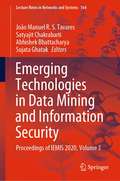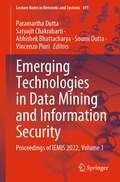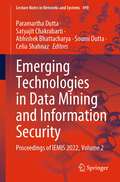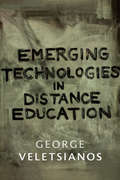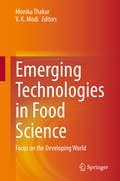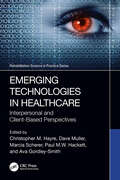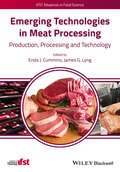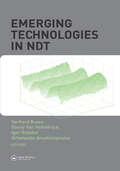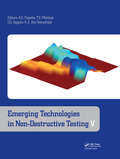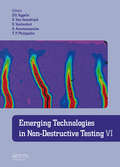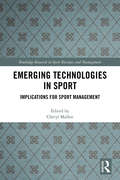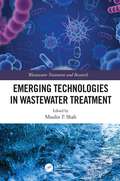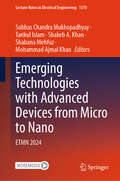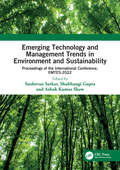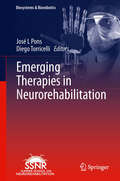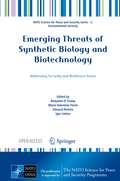- Table View
- List View
Emerging Technologies in Data Mining and Information Security: Proceedings of IEMIS 2020, Volume 2 (Advances in Intelligent Systems and Computing #1300)
by Siddhartha Bhattacharyya Aboul Ella Hassanien Abhishek Bhattacharya Soumi Dutta Satyajit ChakrabatiThis book features research papers presented at the International Conference on Emerging Technologies in Data Mining and Information Security (IEMIS 2020) held at the University of Engineering & Management, Kolkata, India, during July 2020. The book is organized in three volumes and includes high-quality research work by academicians and industrial experts in the field of computing and communication, including full-length papers, research-in-progress papers and case studies related to all the areas of data mining, machine learning, Internet of things (IoT) and information security.
Emerging Technologies in Data Mining and Information Security: Proceedings of IEMIS 2020, Volume 3 (Lecture Notes in Networks and Systems #164)
by João Manuel R. S. Tavares Satyajit Chakrabarti Abhishek Bhattacharya Sujata GhatakThis book features research papers presented at the International Conference on Emerging Technologies in Data Mining and Information Security (IEMIS 2020) held at the University of Engineering & Management, Kolkata, India, during July 2020. The book is organized in three volumes and includes high-quality research work by academicians and industrial experts in the field of computing and communication, including full-length papers, research-in-progress papers, and case studies related to all the areas of data mining, machine learning, Internet of things (IoT), and information security.
Emerging Technologies in Data Mining and Information Security: Proceedings of IEMIS 2022, Volume 1 (Lecture Notes in Networks and Systems #491)
by Vincenzo Piuri Paramartha Dutta Satyajit Chakrabarti Abhishek Bhattacharya Soumi DuttaThis book features research papers presented at the International Conference on Emerging Technologies in Data Mining and Information Security (IEMIS 2022) held at Institute of Engineering & Management, Kolkata, India, during February 23–25, 2022. The book is organized in three volumes and includes high-quality research work by academicians and industrial experts in the field of computing and communication, including full-length papers, research-in-progress papers and case studies related to all the areas of data mining, machine learning, Internet of Things (IoT) and information security.
Emerging Technologies in Data Mining and Information Security: Proceedings of IEMIS 2022, Volume 2 (Lecture Notes in Networks and Systems #490)
by Paramartha Dutta Satyajit Chakrabarti Abhishek Bhattacharya Soumi Dutta Celia ShahnazThis book features research papers presented at the International Conference on Emerging Technologies in Data Mining and Information Security (IEMIS 2022) held at Institute of Engineering & Management, Kolkata, India, during 23–25 February 2022. The book is organized in three volumes and includes high-quality research work by academicians and industrial experts in the field of computing and communication, including full-length papers, research-in-progress papers, and case studies related to all the areas of data mining, machine learning, Internet of Things (IoT) and information security.
Emerging Technologies in Data Mining and Information Security: Proceedings of IEMIS 2022, Volume 3 (Advances in Intelligent Systems and Computing #1348)
by Paramartha Dutta Abhishek Bhattacharya Soumi Dutta Wen-Cheng LaiThis book features research papers presented at the International Conference on Emerging Technologies in Data Mining and Information Security (IEMIS 2022) held at Institute of Engineering & Management, Kolkata, India, during February 23–25, 2022. The book is organized in three volumes and includes high-quality research work by academicians and industrial experts in the field of computing and communication, including full-length papers, research-in-progress papers, and case studies related to all the areas of data mining, machine learning, Internet of Things (IoT), and information security.
Emerging Technologies in Distance Education
by George VeletsianosA one-stop knowledge resource, Emerging Technologies in Distance Education showcases the international work of research scholars and innovative distance education practitioners who use emerging interactive technologies for teaching and learning at a distance. This widely anticipated book harnesses the dispersed knowledge of international experts who highlight pedagogical, organizational, cultural, social, and economic factors that influence the adoption and integration of emerging technologies in distance education.
Emerging Technologies in Electrical Engineering for Reliable Green Intelligence: Proceedings of ICSTACE 2023 (Lecture Notes in Electrical Engineering #1117)
by Mohammad Shahidehpour Sri Niwas Singh Vasundhara Mahajan Anandita ChowdhuryThe book includes peer-reviewed papers from the International Conference on Sustainable Technology and Advanced Computing in Electrical Engineering (ICSTACE 2023). The main focus of the book is to provide the global perspective of sustainable research related to computer advancement in electrical engineering. This involves the areas related to sustainable development. This volume covers artificial intelligence, machine learning, the Internet of Things (IoT), cloud computing, big data analysis, blockchain, cyber security of the smart grid, etc. The book focuses on the areas related to sustainable development and includes research works from academicians and industry experts. The book discusses new challenges and provides solutions at the interface of technology, information, complex systems, and future research directions.
Emerging Technologies in Food Preservation
by Santosh Kumar Avik Mukherjee Atanu Mitra Dipankar HalderConsumers worldwide are becoming increasingly aware of the significant impacts of food quality, nutrition, and food habits on their health. Demands for fresh, minimally processed foods, foods subjected to less severe preservation and processing, and for foods with no synthetic chemical preservatives are expanding rapidly. Food businesses worldwide are innovating advanced processing and preservation technologies, including natural, bioactive preservatives to fulfill these emerging consumers’ demands. Emerging Technologies in Food Preservation discusses the innovations and advancements in food processing and preservation that have emerged over the last two decades of the 21st century. Various experts in the field examine different innovative food processing and preservation technologies, including non-thermal and minimal processing technologies, particularly those that have least destructive impact on micronutrients. Key Features: Describes the hurdles and challenges in commercialization of these novel processing technologies, including their legal ramifications on food regulations and legislations. Provides detail accounts of application of each of the novel food preservation principles, as they are applied in commercial food processing / food manufacturing lines worldwide. Features a complete account on recent developments and advancements in food preservation and processing technologies, including natural and biopreservatives Mindful of the increasing interest in alternatives to traditional thermal processing of foods and beverages, this book is a valuable reference for students, scholars, researchers, scientists, food entrepreneurs, as well as technical professionals working in food industries and associated businesses.
Emerging Technologies in Food Science: Focus on the Developing World
by Monika Thakur V. K. ModiThis book provides a comprehensive review of recent innovations in food science that are being used to tackle the challenges of food safety, nutritional security and sustainability. With a major focus on developing nations, like India, the book is divided into four main sections. The first section provides an overview of the food industry, while the second explores food safety in various segments, with an interesting account of street food safety – an important, yet often neglected aspect for safety parameters. The third section, on nutritional security and sustainability, explores various ways of maximizing nutrition and optimizing waste management in the food industry. The book closes with a section on emerging technologies and innovations, which introduces readers to some of the latest technologies in the food industry, including advances in food processing, packaging, nanotechnology, etc. The topics have been divided into 25 different chapters, which offer a diverse blend of perspectives on innovations in the developing world. Ideally suited for students and researchers in the food sciences, the book is also an interesting read for industry experts in Food Science and Technology.
Emerging Technologies in Healthcare: Interpersonal and Client Based Perspectives (Rehabilitation Science in Practice Series)
by Christopher M. Hayre, Dave Muller, Marcia Scherer, Paul M.W. Hackett, and Ava Gordley-SmithThis edited book focuses on the role and use of emerging technologies within the healthcare sector. This text draws on expertise from leading practitioners and researchers who either utilize and/or are at the forefront of researching with emerging technology in anticipation of enhancing patient outcomes.Emerging Technologies in Healthcare: Interpersonal and Client-Based Perspectives focuses on the role of emerging technologies in society and how it may enhance medical treatment, management, and rehabilitation of service users. It offers expert perspectives on topics covering emerging technological advances and how they are being incorporated into healthcare, but also critically appraises forthcoming implementation. The editors draw from recent publications and the growing narrative surrounding technological advances, notably telerehabilitation, virtual reality, augmentation, and mHealth. Subsequent chapters focus on these, coupled with other emerging technologies, providing detailed insight into how these can either enhance and/or hinder patient/service user outcomes. Each chapter explores the multifaceted use and application of each emerging technology, that impacts on diagnosis, treatment, and (self-) management of individuals. For example, can emerging technology really facilitate patient diagnosis, improve, or remove practitioner–patient interactions, provide sound rehabilitation, and treat/monitor mental health conditions?This edited volume encompasses an array of emerging technologies that will remain pertinent to caregivers, families, practitioners, service users and policymakers. This is not a text on emerging technology alone but on its societal implications, accompanied by ethical, altruistic, and moral examples for such advances within the healthcare field. It is targeted that this text will enhance and offer original discussions surrounding the interconnectivity of technology and medicine, rehabilitation, and patient care.
Emerging Technologies in Manufacturing
by Matthew N. Sadiku Abayomi J. Ajayi-Majebi Philip O. AdeboThe manufacturing industry is a cornerstone of national economy and people’s livelihood. It is the way of transforming resources into products or goods which are required to cater to the needs of the society. Traditional manufacturing companies currently face several challenges such as rapid technological changes, inventory problem, shortened innovation, short product life cycles, volatile demand, low prices, highly customized products, and ability to compete in the global markets. Modern manufacturing is highly competitive due to globalization and fast changes in the global market. This book reviews emerging technologies in manufacturing. These technologies include artificial intelligence, smart manufacturing, lean manufacturing, robotics, automation, 3D printing, nanotechnology, industrial Internet of things, and augmented reality. The use of these technologies will have a profound impact on the manufacturing industry. The book consists of 19 chapters. Each chapter addresses a single emerging technology in depth and describes how manufacturing organizations are adopting the technology. The book fills an important niche for manufacturing. It is a comprehensive, jargon-free introductory text on the issues, ideas, theories, and problems on emerging technologies in manufacturing. It is a must-read book for beginners or anyone who wants to be updated about emerging technologies.
Emerging Technologies in Meat Processing: Production, Processing and Technology
by Enda J. Cummins James G. LyngMeat is a global product, which is traded between regions, countries and continents. The onus is on producers, manufacturers, transporters and retailers to ensure that an ever-demanding consumer receives a top quality product that is free from contamination. With such a dynamic product and market place, new innovative ways to process, package and assess meat products are being developed. With ever increasing competition and tighter cost margins, industry has shown willingness to engage in seeking novel innovative ways of processing, packaging and assessing meat products while maintaining quality and safety attributes. This book provides a comprehensive overview on the application of novel processing techniques. It represents a standard reference book on novel processing, packaging and assessment methods of meat and meat products. It is part of the IFST Advances in Food Science book series.
Emerging Technologies in NDT
by Igor Solodov Danny Van Hemelrijck Athanasios Anastasopoulos Gerhard BusseNon-destructive testing (NDT) is a pertinent task in nearly every field of human activity, from the assuring of aircraft integrity to the evaluation of infrastructural decay caused by deterioration or damage. The development of non-destructive methods for quality management results in economic and environmental benefits, in an increase in
Emerging Technologies in NDT: Proceedings of the 2nd International Conference, Thessaloniki, Greece, 1999
by Danny Van Hemelrijck, Athanassios Anastassopoulos, Theodore PhilippidisThis volume contains the papers presented at the 2nd International Conference entitled: "Emerging Technologies in NDT" which was held in Athens, Greece, May 24-26, 1999. This work covers frequently used non-destructive testing methods and introduces innovative ideas in the field. The title also focuses on visual and optical inspection, acoustic emission and ultrasonics as well as a range of other closely related topics.More than 50 papers were presented at the conferecne by invited and distinguished researchers from all over the world. This volume forms a valuable record of important contributions to the relevant literature. It contains not only the most up-to-date technology developments but provides also information regarding emerging NDT techniques/technologies and their potential applications in the field. The book covers frequently used NDT methods and introduces new and innovative ideas. Focussing on visual and optical inspection, acoustic emission, ultrasonics, nonlinear ultrasonics, infrared methods, X-ray radiography, special techniques, material characterisation, NDT of civil engineering structures, inspection of pipes and reliability and validation this volume will be a great boon to engineers, researchers, quality control managers, as well as teachers and graduate students in the field.
Emerging Technologies in Non-Destructive Testing V
by D. Van Hemelrijck A. S. Paipetis T. E. Matikas D. G. AggelisNon-destructive evaluation (NDE) methods have dominated most of the fields of applied research and technology over the last twenty years. These techniques provide information on the functional efficiency of materials and structures without causing any structural impact on the structure itself. Their use enables the monitoring of the structural inte
Emerging Technologies in Non-Destructive Testing VI: Proceedings of the 6th International Conference on Emerging Technologies in Non-Destructive Testing (Brussels, Belgium, 27-29 May 2015)
by D. G. Aggelis S. Vanlanduit A. AnastasopoulosNon-Destructive Testing (NDT) is of worldwide significance, and is strongly related to the detection of damage in engineering structures (buildings, bridges, aircrafts, ships, pressure vessels, etc.) using non-invasive techniques (ultrasound, X-rays, Radar, neutrons, thermography, vibrations, acoustic emission, etc.). Emerging Technologies in Non-D
Emerging Technologies in Sport: Implications for Sport Management (Routledge Research in Sport Business and Management)
by Cheryl MallenAdvances in technology have always had a significant impact on sport. This book surveys the next generation of emerging technologies and considers how sport managers, governing bodies and officials can meet the challenges that they pose for sport competition, participation and events. It explores cutting edge developments in areas such as gene doping, vision and brain technologies, 3D printing technologies, molecular communication technologies and our ability to "rebuild" bodies. Each chapter considers the implications of a particular technology in terms of ethics, rules and regulations, facilities and resourcing, as well as the emergence of completely new forms of sport, and offers strategies for future sport management. Emerging Technologies in Sport is a valuable resource for sport industry professionals, undergraduate students in the fields of sport management, sport tourism, and sport business, and a fascinating read for anyone with an interest in sport and future applications of emerging technologies within sport.
Emerging Technologies in Wastewater Treatment (Wastewater Treatment and Research)
by Maulin P. ShahEmerging technologies in wastewater treatment plant is an ecological, profitable and natural technology designed to eliminate heavy metals, radionuclides, xenobiotic compounds, organic waste, pesticides, etc. from contaminated sites or industrial downloads through biological means. Since this technology is used in conditions on site, it does not physically disturb the site unlike conventional methods, that is, chemical or mechanical methods. In this technology, higher plants or microbes are used alone or in combination for the phytoextraction of heavy metals from sites contaminated with metals. Through microbial interventions, metals are immobilized or mobilized through redox conversions in contaminated sites. If they are mobilized, accumulating metal plants are placed to accumulate metals in their bodies. Next, metal-loaded plants are collected and recycled to reduce the volume of waste and then, disposed of as hazardous materials or used for the recovery of precious metals, if possible. In case of immobilization, metals are no longer available to be toxic to organisms. There are very few books published on the proposed theme. A good number of books have been published on environmental bioremediation, but the proposed book is a new and an innovative proposal specifically in wastewater treatment. Looking into the importance of emerging technologies in wastewater treatment research, the book will have a high and applicable value in industrial wastewater treatment research. Features: The book highlights the importance of emerging technologies in the wastewater treatment plant to clean up the environment from pollution caused by human activities. It assesses the potential application of several existing bioremediation techniques and introduces new emerging technologies. It is an updated vision of the existing emerging technologies in environmental bioremediation strategies with their limitations and challenges and their potential application to remove environmental pollutants. It also introduces the new trends and advances in environmental bioremediation with a thorough discussion of recent developments in this field. Highlights the importance of bioremediation to deal with the ever-increasing number of environmental pollutants.
Emerging Technologies with Advanced Devices from Micro to Nano: ETMN 2024 (Lecture Notes in Electrical Engineering #1370)
by Subhas Chandra Mukhopadhyay Tarikul Islam Shabana Mehfuz Shakeb A. Khan Mohammad Ajmal KhanThis book presents the proceedings of the 6th International Conference on Emerging Technologies: Micro to Nano (ETMN), held in New Delhi, India, on November 22-23, 2024. It showcases advances and innovations in micro and nanotechnologies and covers topics such as nano composites, nano materials, micro/nano fluidics, micro optics, organic and flexible electronics, advanced materials for nano devices, MEMS, smart biomimetic sensors, electrochemical sensors, acoustic and optical sensors, micro/nano sensors, wearable sensors, intelligent instrumentation, micro/nano electronics, nano antenna and RF system design, wireless sensor networks, applications of AI and IoT-based system, and structural health monitoring (SHM).
Emerging Technology and Management Trends in Environment and Sustainability: Proceedings of the International Conference, EMTES-2022
by Sushovan Sarkar Shubhangi Gupta Ashok Kumar ShawThe International Conference (EMTES 2022) is oriented to include the themes like Water Quality Management, Advanced Water Treatment, Advanced Wastewater Treatment, Assessment and Control of Air Pollution, Solid and Hazardous Waste Management, Prevention of Groundwater Contamination, Wetland Management/Phyto-remediation, Case studies in Industrial Pollution Control, Liquid waste management, recent advancement in engineering, technology and management for optimization of environmental issues, application of IOT and IT in remedial measure of Environment and sustainability, Health issues and safety.
Emerging Technology in Modelling and Graphics: Proceedings of IEM Graph 2018 (Advances in Intelligent Systems and Computing #937)
by Jyotsna Kumar Mandal Debika BhattacharyaThe book covers cutting-edge and advanced research in modelling and graphics. Gathering high-quality papers presented at the First International Conference on Emerging Technology in Modelling and Graphics, held from 6 to 8 September 2018 in Kolkata, India, it addresses topics including: image processing and analysis, image segmentation, digital geometry for computer imaging, image and security, biometrics, video processing, medical imaging, and virtual and augmented reality.
Emerging Therapies in Neurorehabilitation
by Diego Torricelli José L PonsThis book reports on the latest technological and clinical advances in the field of neurorehabilitation. It is, however, much more than a conventional survey of the state-of-the-art in neurorehabilitation technologies and therapies. It was formed on the basis of a week of lively discussions between curious PhD students and leading research experts during the summer school on neurorehabilitation (SSNR2012), September 16-21 in Nuévalos, Zaragoza (Spain). Its unconventional format makes it a perfect guide for all PhD students, researchers and professionals interested in gaining a multidisciplinary perspective on current and future neurorehabilitation scenarios. The book covers various aspects of neurorehabilitation research and practice, organized into different parts. The first part discusses a selection of common impairments affecting brain function, such as stroke, cerebral palsy and Parkinson's disease; the second deals with both spinal cord and brain plasticity. The third part covers the most recent rehabilitation and diagnostics technologies, including robotics, neuroprostheses, brain-machine interfaces and electromyography systems. Practical examples and case studies related to the application of some of the latest techniques in realistic clinical scenarios are covered in the fourth part.
Emerging Therapies in Neurorehabilitation III: Proceedings of the 10/11/12th Summer School on Neurorehabilitation (SSNR), held in 2022, 2023, 2024, in Baiona, Spain (Biosystems & Biorobotics #34)
by Dario Farina Jose L. Pons Jesus TorneroThis book offers a timely snapshot of research of biomedical and neural engineering, and their applications in neurorehabilitation. It gathers peer-reviewed contributions to three different conference editions (of the series Summer School on Neurorehabilitation (SSNR)) , which were held in Baiona, Spain, on June 12–17, 2022, June 11–16, 2023, and June 16–21, 2024, respectively. They report on applications of cutting-edge neuroprosthetic devices, robotic interfaces, and related technologies to assist patients with neurologic and musculoskeletal conditions, such as stroke, spinal cord injury, and amputation, among others. A special feature consists of the fact that both technological and clinical issues are discussed, providing readers with a multidisciplinary perspective on neurorehabilitation research and practice.
Emerging Threats of Synthetic Biology and Biotechnology: Addressing Security and Resilience Issues (NATO Science for Peace and Security Series C: Environmental Security)
by Igor Linkov Benjamin D. Trump Marie-Valentine Florin Edward PerkinsSynthetic biology is a field of biotechnology that is rapidly growing in various applications, such as in medicine, environmental sustainability, and energy production. However these technologies also have unforeseen risks and applications to humans and the environment. This open access book presents discussions on risks and mitigation strategies for these technologies including biosecurity, or the potential of synthetic biology technologies and processes to be deliberately misused for nefarious purposes. The book presents strategies to prevent, mitigate, and recover from ‘dual-use concern’ biosecurity challenges that may be raised by individuals, rogue states, or non-state actors. Several key topics are explored including opportunities to develop more coherent and scalable approaches to govern biosecurity from a laboratory perspective up to the international scale and strategies to prevent potential health and environmental hazards posed by deliberate misuse of synthetic biology without stifling innovation. The book brings together the expertise of top scholars in synthetic biology and biotechnology risk assessment, management, and communication to discuss potential biosecurity governing strategies and offer perspectives for collaboration in oversight and future regulatory guidance.
Emerging Topics in Hardware Security
by Mark TehranipoorThis book provides an overview of emerging topics in the field of hardware security, such as artificial intelligence and quantum computing, and highlights how these technologies can be leveraged to secure hardware and assure electronics supply chains. The authors are experts in emerging technologies, traditional hardware design, and hardware security and trust. Readers will gain a comprehensive understanding of hardware security problems and how to overcome them through an efficient combination of conventional approaches and emerging technologies, enabling them to design secure, reliable, and trustworthy hardware.

